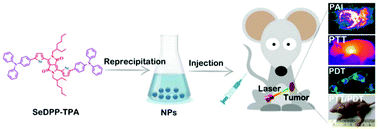A selenophene substituted diketopyrrolopyrrole nanotheranostic agent for highly efficient photoacoustic/infrared-thermal imaging-guided phototherapy†
Abstract
Phototherapy, a light-induced cancer therapy, has presented great promise for multimodal cancer treatment. Herein, a selenophene substituted diketopyrrolopyrrole based nanotheranostic photosensitizer (SeDPP-TPA) has been designed and synthesized. The introduction of selenophene enables SeDPP-TPA to produce a high yield of singlet oxygen (1O2) (ΦΔ = 40.2%), and show a bathochromic shift in absorbance (λmax at 648 nm), enhanced charge transfer and biocompatibility. After nanoprecipitation, SeDPP-TPA nanoparticles (NPs) are prepared with excellent water dispersibility and passive tumor-targeting properties based on the enhanced permeability and retention effect. Besides, SeDPP-TPA NPs present a high photothermal conversion efficiency (η = 37.9%). An in vitro cytotoxicity test shows that the half-maximal inhibitory concentration (IC50) of SeDPP-TPA NPs on tumor cells is ∼12 μg mL−1, indicating their excellent phototherapy efficiency. What is more, because of the thermal expansion and tumor-targeting properties, SeDPP-TPA NPs can also act as a contrast agent for photoacoustic imaging to visualize the therapy in vivo. Coupled with the infrared thermal imaging properties of the photothermal agent, SeDPP-TPA NPs are proved to be a multifunctional theranostic agent for dual-modal imaging-guided phototherapy.



 Please wait while we load your content...
Please wait while we load your content...